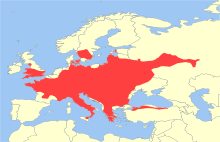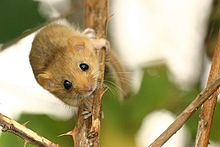- Hazel Dormouse
-
Hazel Dormouse
Temporal range: Middle Miocene - RecentConservation status Scientific classification Kingdom: Animalia Phylum: Chordata Class: Mammalia Order: Rodentia Family: Gliridae Subfamily: Leithiinae Genus: Muscardinus
Kaup, 1829Species: M. avellanarius Binomial name Muscardinus avellanarius
(Linnaeus, 1758)
Geographic range The Hazel Dormouse or Common Dormouse (Muscardinus avellanarius) is a small mammal and the only living species in the genus Muscardinus.[2] It is 6 to 9 centimetres (2.4 to 3.5 in) long with a tail of 5.7 to 7.5 centimetres (2.2 to 3.0 in). It weighs 17 to 20 grams (0.60 to 0.71 oz), although this increases to 30 to 40 grams (1.1 to 1.4 oz) just before hibernation. The Hazel Dormouse hibernates from October to April-May.
The Hazel Dormouse is native to northern Europe and Asia Minor. It is the only dormouse native to the British Isles (though the edible dormouse, Glis glis, has been accidentally introduced and now has an established population), and is therefore often referred to simply as the Dormouse in British sources.
The United Kingdom distribution of the Hazel Dormouse can be found on the National Biodivestity Network website. here
Contents
Description
The Hazel Dormouse has golden-brown fur and large black eyes. It is a nocturnal creature and spends most of its waking hours among the branches of trees looking for food. It will make long detours rather than come down to the ground and expose itself to danger.
Behaviour
In winter (early October), the Hazel Dormouse will hibernate in nests beneath the leaf litter on the forest floor. When it wakes up in spring (late April or early May), it builds woven nests of shredded honeysuckle bark, fresh leaves and grasses in the undergrowth. If the weather is cold and wet, and food scarce, it saves energy by going into torpor; it curls up into a ball and goes to sleep. The Hazel Dormouse, therefore, spends a large proportion of its life sleeping − either hibernating in winter or in torpor in summer.
Examination of hazelnuts may show a neat round hole in the shell. This indicates that it has been opened by a small rodent, e.g., the dormouse, wood mouse, or bank vole. Other animals such as squirrels or jays will either split the shell completely in half or make a jagged hole in it.
Further examination reveals that the inner rim of the hole has toothmarks which are at an angle to the hole for the dormouse. The toothmarks are parallel with rough marks on the nut surface for a wood mouse; the bank vole leaves parallel grooves with no rough marks.
Diet
It feeds on a wide variety of arboreal foods:
- flowers for nectar and pollen
- fruits - berry and nuts
- insects - especially aphids and caterpillars
- buds of young leaves
- Hazel - the main food for fattening up before hibernation, although the tree is also an important provider of insects.
- Hornbeam and blackthorn fruit where hazel is scarce
A variety of different food sources available at different times of year is required to ensure the Hazel Dormouse survives.
Habitat
- Woodland
- Hedgerows - These are species rich and connected to woodland. Ideally they are three to four metres high, and left at least seven years before cutting, because many shrubs do not begin to fruit until that time period has passed.
- Nestboxes
- They usually only travel less than 70 metres from their nest.[3]
Protection status
The Hazel Dormouse is a European Protected Species and is protected in the UK under the Wildlife and Countryside Act.
Plants of value to dormice
- Hazel - principal food source, supports insects. Forms an understory of poles, especially when coppiced, which makes it useful for its arboreal activity. The Hazel Dormouse's Latin name avellanarius means 'hazel'.
- Oak - insect and flower food. Acorns are of little value.
- Honeysuckle - bark is nesting material. Flowers and fruit are food.
- Bramble - flowers and fruits provide food over a long period. Thorns give protection for nests. Dormice thrive on blackberries.
- Sycamore - insect and pollen, and a habitat. However they cast a dense shade which decreases the understory.
- Ash - seed keys whilst they are still on the tree
- Viburnum lantana - fruits and flowers
- Yew - fruits are a favoured food
- Hornbeam - seeds
- Broom - flowers (in early Summer)
- Sallow - unripe seeds, supports many insects
- Birch - seeds
- Sweet chestnut - chestnut an excellent foodsource, the flowers are eaten as well
- Blackthorn - fruits are eaten
- Hawthorn - flowers are an important food in the spring. The fruit is eaten occasionally[4]
Threats
- Predation from Eurasian badger, fox, stoat, weasel
- Trampling, e.g., deer, human
- Lack of food source, e.g., from too frequent hedge-trimming, or competition from other species, e.g., squirrels
- Destruction of forest and hedgerow habitats, or their diverse range of species, as a broad spectrum of food is required across the calendar year.
- droppings from large animals
References
- ^ Amori, G., Hutterer, R., Kryštufek, B., Yigit, N., Mitsain, G., Meinig, H. & Juškaitis, R. (2008). Muscardinus avellanarius. In: IUCN 2008. IUCN Red List of Threatened Species. Downloaded on 29 October 2009.
- ^ Mitchell-Jones, A. J., Amori, G., Bogdanowicz, W., Kryštufek, B., Reijnders, P.J.H., Spitzenberger, F., Stubbe, M., Thissen, J.B.M., Vohralik, V. & Zima, J. (1999). The atlas of European Mammals. London: Academic Press. pp. 484.
- ^ The Dormouse Conservation handbook published by Natural England
- ^ Hedgerows for Dormice
External links
- Peoples Trust for Endangered Species site describing the Hazel Dormouse and its conservation
- Information and images from the BBC
- Extensive information and pictures
- Pet care
- A lot of facts, links and book reviews about the dormouse
- Dormouse nest-box construction
Categories:- IUCN Red List least concern species
- Dormice
- Mammals of Europe
- Mammals of Asia
- Mammals of the United Kingdom
- Fauna of Jersey
- Fauna of Guernsey
- Mammals of France
- Mammals of the Netherlands
- Mammals of Belgium
- Mammals of Luxembourg
- Mammals of Monaco
- Mammals of Italy
- Mammals of Switzerland
- Mammals of Liechtenstein
- Mammals of Austria
- Mammals of Germany
- Mammals of Denmark
- Mammals of the Czech Republic
- Mammals of Poland
- Mammals of Slovakia
- Mammals of Slovenia
- Mammals of Croatia
- Mammals of Bosnia and Herzegovina
- Mammals of Serbia
- Mammals of Montenegro
- Mammals of Kosovo
- Mammals of Albania
- Mammals of the Republic of Macedonia
- Mammals of Greece
- Mammals of Bulgaria
- Mammals of Romania
- Mammals of Hungary
- Mammals of Moldova
- Mammals of Ukraine
- Mammals of Belarus
- Mammals of Estonia
- Mammals of Latvia
- Mammals of Lithuania
- Mammals of Russia
- Mammals of Turkey
- Mammals of Sweden
- Mammals of Great Britain
- Animals described in 1758
Wikimedia Foundation. 2010.


